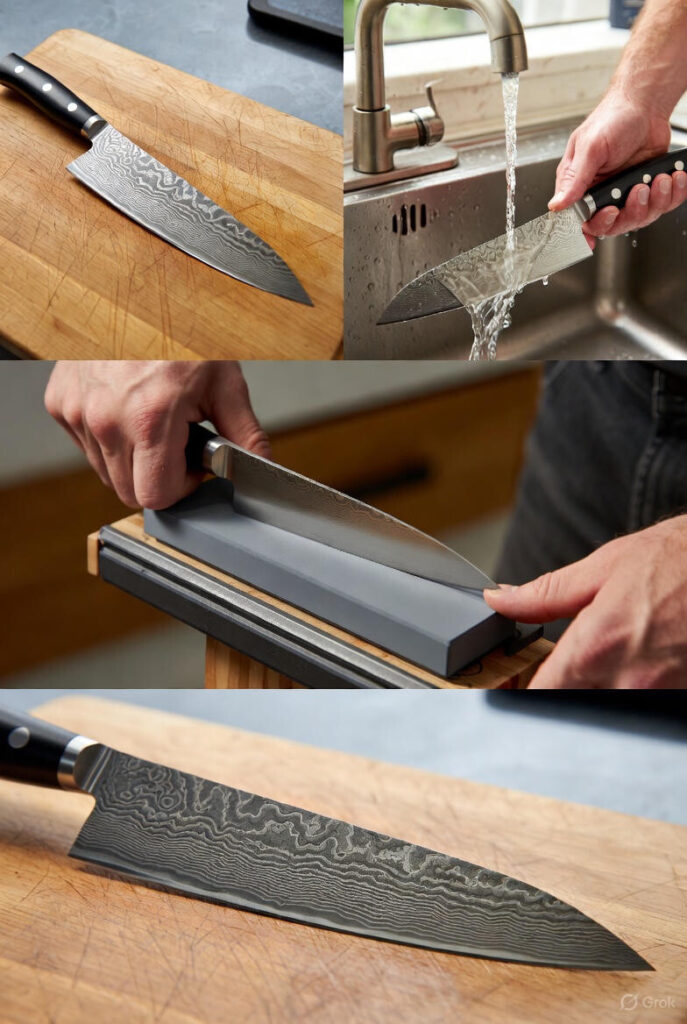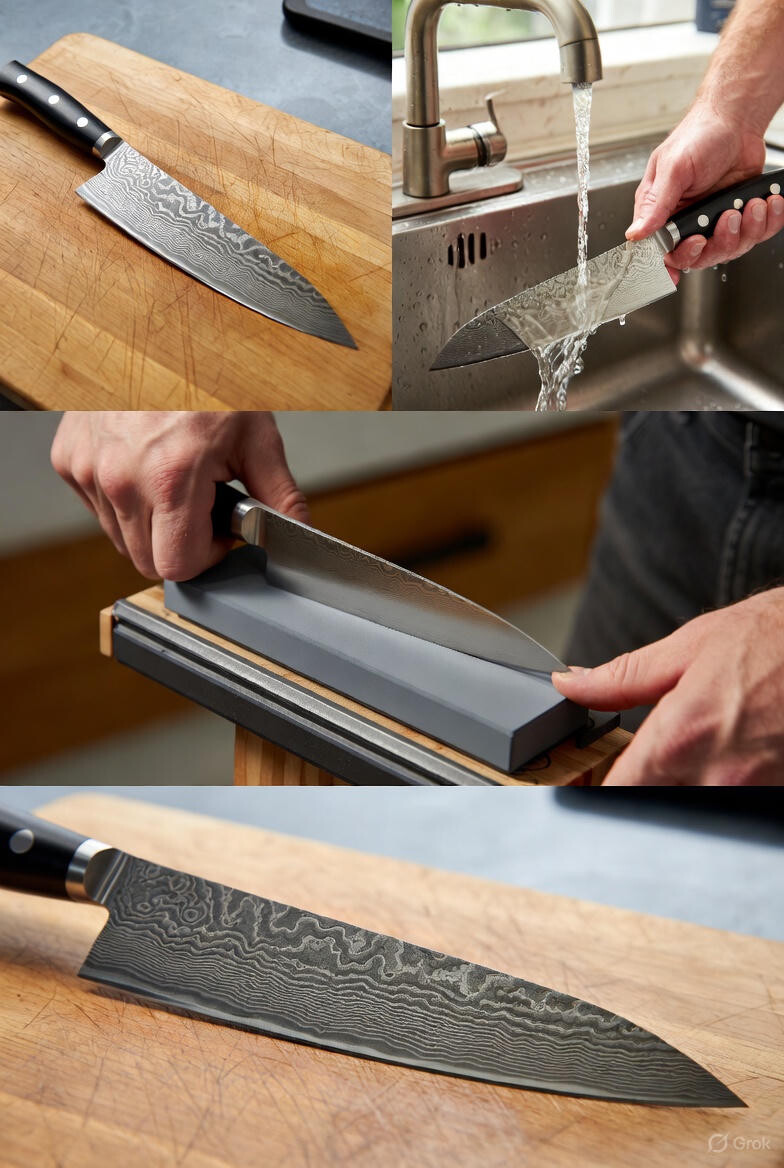Damascus Steel Knife Care Method: Ultimate Maintenance Guide for Long-Lasting Sharpness

Damascus steel knives are prized for their stunning layered patterns, exceptional hardness, and razor-sharp edges. Crafted through a forging process that folds multiple steel types, these blades combine beauty with performance. However, improper handling can lead to chipping, rust, or dulling. This comprehensive Damascus steel knife care method guide covers maintenance, precautions, and sharpening techniques to keep your knife in peak condition. Follow these tips to extend its lifespan and maintain that signature wave pattern.
Why Proper Damascus Steel Knife Maintenance Matters
Damascus steel is notoriously hard (often 58-62 HRC), making it brittle if misused. Without the right Damascus steel knife care method, you risk:
- Edge chipping or rolling from lateral force
- Rust spots due to moisture or acidic foods
- Pattern damage from aggressive sharpening
- Reduced cutting performance over time
Investing just a few minutes in daily care ensures your knife stays sharp, beautiful, and safe for years.
Damascus Steel Knife Maintenance: 6 Essential Rules
Follow these proven maintenance methods to protect your investment:
1. Use the Right Cutting Surface
- ✅ Allowed: Wooden, bamboo, or soft plastic boards
- ❌ Avoid: Glass, ceramic, marble, metal, or stone surfaces
- Frozen foods must be fully thawed before cutting to prevent micro-fractures.
2. Never Strike or Pry with the Blade
- Do not use the knife to hit, chop bones, or pry open cans.
- Avoid cutting on reinforced composite boards, these can chip even the toughest Damascus edges.
3. Cut Straight, Avoid Side-to-Side Rocking
- Damascus steel’s high hardness means lateral swinging causes edge collapse.
- Use controlled, downward slicing motions.
- This prevents micro-chips and maintains a clean cutting edge.
4. Clean and Dry Immediately After Use
- Rinse with clean water (never soak in saltwater).
- Wipe dry with a soft cloth, do not air dry.
- Store in a dry, ventilated area away from humidity.
- Avoid dishwashers, detergents and prolonged moisture cause pitting.
5. Match the Knife to the Task
- Use specialized blades for specific foods:
- Slicing knife → Meats, fish
- Vegetable knife → Produce
- Boning knife → Poultry
- Mismatched use accelerates wear and reduces efficiency.
6. Sharpen Only with Professional Tools
- ❌ Never use: Coarse whetstones, pull-through sharpeners, or steel rods
- ✅ Use: Fine-grit whetstone (1000–6000 grit) or ceramic honing rod
- Aggressive grinding destroys the Damascus pattern and steel core.
Pro Tip: Purchase a fine whetstone from your knife retailer to maintain the blade’s integrity.
Precautions for Safe Use
1. Hand Wash Only
- Use warm water and mild soap.
- Dry immediately to prevent oil stains or rust.
- Dishwashers cause blade vibration and chemical corrosion.
2. Avoid Hard or Frozen Foods
- Cutting small bones, cartilage, or frozen items can cause edge rollout.
- For bones, use a cleaver.
- After heavy use, re-hone the edge and apply a thin layer of food-grade mineral oil.
3. Post-Use Ritual
- Rinse → Wipe → Dry → Oil (lightly) → Store upright or on a magnetic strip.
- This prevents moisture trapping and blade contact.
Rust Alert: Stainless Damascus can still rust if neglected. Act fast, use a rust eraser for minor spots.
How to Sharpen Damascus Steel Knives (Step-by-Step)
Sharpening Damascus requires precision to preserve the pattern. Here’s the correct grinding method:
Tools Needed:
- Fine whetstone (1000/6000 grit)
- Water (for soaking stone)
- Towel
- Angle guide (optional)
Technique:
- Soak the whetstone for 10–15 minutes.
- Hold the knife at 20°–25° (match the original bevel).
- Left Edge (Left Side):
- Grip handle with right hand.
- Press spine with left fingers.
- Draw blade down and across the stone (heel to tip).
- Right Edge (Right Side):
- Reverse hands.
- Same motion, down and across.
- Alternate sides for 8–10 strokes each.
- Finish on 6000-grit side for a polished edge.
- Strop on leather (optional) for hair-popping sharpness.
Visual Guide:
- Left motion: ↙️ (left edge)
- Right motion: ↘️ (right edge)
- Maintain consistent 20°–25° angle
Common Mistakes to Avoid
| Mistake | Consequence | Fix |
|---|---|---|
| Using a dishwasher | Rust + pattern fade | Hand wash only |
| Rocking on hard boards | Chipped edge | Use end-grain wood |
| Coarse sharpening | Ruined pattern | Use 1000+ grit stones |
| Storing wet | Pitting | Dry + oil blade |
Final Thoughts: Protect Your Damascus Masterpiece
Your Damascus steel knife is more than a tool, it’s a work of art. By following this Damascus steel knife care method, you’ll enjoy:
- Razor-sharp performance for years
- Pristine wave patterns without scratches
- Rust-free, hygienic blade
Quick Care Checklist:
- Cut on wood/plastic
- Hand wash & dry
- Store dry
- Sharpen at 20°–25°
- Oil monthly
Implement these habits today, and your Damascus knife will reward you with flawless cuts tomorrow.
Tags: Damascus steel knife care, knife maintenance guide, how to sharpen Damascus steel, knife sharpening angle, prevent knife rust, best cutting board for knives
Share this content:
